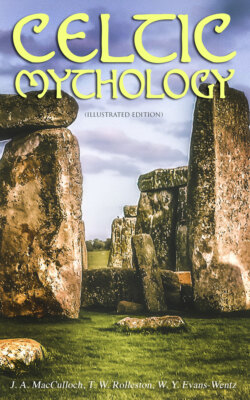Читать книгу CELTIC MYTHOLOGY (Illustrated Edition) - T. W. Rolleston - Страница 46
The Ship Symbol in Egypt
ОглавлениеNow this symbol of the ship, with or without the actual portrayal of the solar emblem, is of very ancient and very common occurrence in the sepulchral art of Egypt. It is connected with the worship of Rā, which came in fully 4000 years B.C. Its meaning as an Egyptian symbol is well known. The ship was called the Boat of the Sun. It was the vessel in which the Sun-god performed his journeys; in particular, the journey which he made nightly to the shores of the Other-world, bearing with him in his bark the souls of the beatified dead. The Sun-god, Rā, is sometimes represented by a disk, sometimes by other emblems, hovering above the vessel or contained within it. Any one who will look over the painted or sculptured sarcophagi in the British Museum will find a host of examples. Sometimes he will find representations of the life-giving rays of Rā pouring down upon the boat and its occupants. Now, in one of the Swedish rock-carvings of ships at Backa, Bohuslän, given by Montelius, a ship crowded with figures is shown beneath a disk with three descending rays, and again another ship with a two-rayed sun above it. It may be added that in the tumulus of Dowth, which is close to that of New Grange and is entirely of the same character and period, rayed figures and quartered circles, obviously solar emblems, occur abundantly, as also at Loughcrew and other places in Ireland, and one other ship figure has been identified at Dowth
Egyptian Solar Bark, XXII Dynasty
Egyptian Solar Bark, with god Khnemu and attendant deities
In Egypt the solar boat is sometimes represented as containing the solar emblem alone, sometimes it contains the figure of a god with attendant deities, sometimes it contains a crowd of passengers representing human souls, and sometimes the figure of a single corpse on a bier. The megalithic carvings also sometimes show the solar emblem and sometimes not; the boats are sometimes filled with figures and are sometimes empty. When a symbol has once been accepted and understood, any conventional or summary representation of it is sufficient. I take it that the complete form of the megalithic symbol is that of a boat with figures in it and with the solar emblem overhead. These figures, assuming the foregoing interpretation of the design to be correct, must clearly be taken for representations of the dead on their way to the Other-world. They cannot be deities, for representations of the divine powers under human aspect were quite unknown to the Megalithic People, even after the coming of the Celts—they first occur in Gaul under Roman influence. But if these figures represent the dead, then we have clearly before us the origin of the so-called “Celtic” doctrine of immortality. The carvings in question are pre-Celtic. They are found where no Celts ever penetrated. Yet they point to the existence of just that Other-world doctrine which, from the time of Cæsar downwards, has been associated with Celtic Druidism, and this doctrine was distinctively Egyptian.
Egyptian Bark, with figure of Rā holding an Ankh, enclosed in Solar Disk. XIX Dynasty
